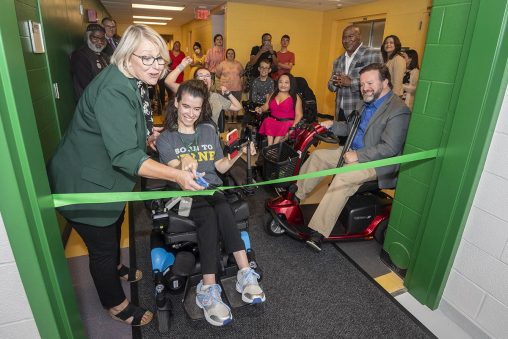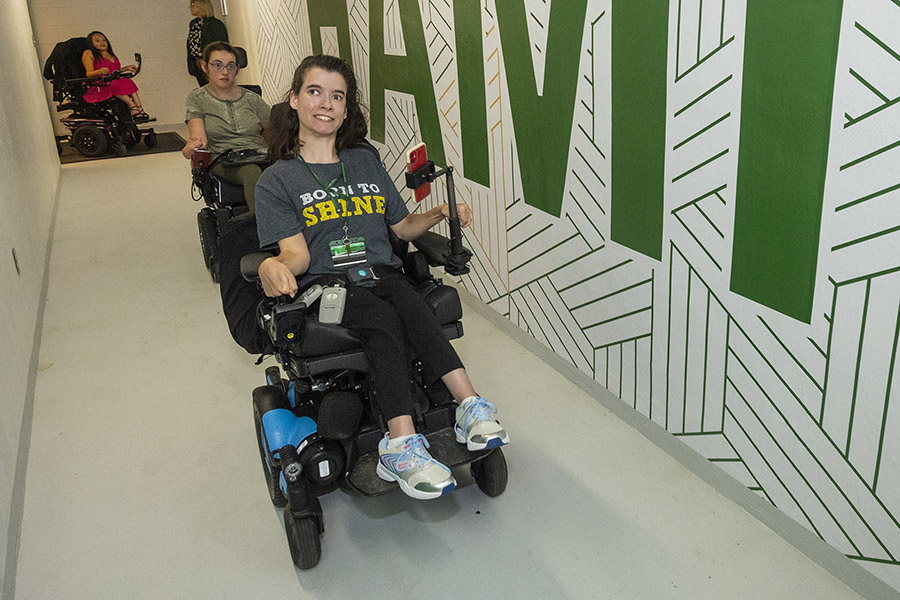
Wright State University celebrated the reopening of a tunnel connecting Hamilton Hall to the Student Union, making the Dayton campus more accessible than ever to students with disabilities who live in the residence hall.
Wright State University’s Office of Disability Services and Department of Inclusive Excellence have announced two new campus features that highlight Wright State’s ongoing commitment to a positive and productive learning environment for students of all abilities and backgrounds.
Students with disabilities living in Hamilton Hall will have easier access to the student union center by renovating and reopening a long-closed portion of Wright State University’s tunnel system, which has been closed for decades due to safety concerns.
“A great deal of work has been done to make the tunnels accessible and safe, including installing cameras and access controls to ensure only Hamilton Hall residents can enter the housing,” said Tom Webb, who was recently promoted to vice president of accessibility.
Wright State University’s Dayton campus is one of the most accessible universities in the country thanks to a tunnel system that connects 20 of the 23 buildings in the academic section of campus with two miles of tunnels. Tunnel systems are a key component of an accessible environment for people with disabilities, and Wright State’s tunnels were designed with that in mind.
Sarah Davis, an undergraduate majoring in organizational leadership, said coming to Wright State from Atlanta was a deliberate choice because of the excellent support offered to students with disabilities.
She said advocating for the tunnel to be reopened is a cause close to her heart, and that when she proposed the idea, Chancellor Sue Edwards not only listened to her, but quickly took the necessary steps.
“I have a deep respect for the great work that Wright State does, especially the Office of Disability Services,” Davis said. “Their impact goes beyond benefiting individuals like me. They play a vital role in improving the overall experience for our diverse student body, representing many different cultures and communities.”
Wright State also opened the Disability and Neurodiversity Cultural Center in the 023 Student Union.
“We’re really excited that this will be a resource for our students. We’re one of only 18 schools in the nation and only the second in Ohio,” Webb said.

Students with disabilities who live in Hamilton Hall now have easier access to campus thanks to the reopening of part of Wright State University’s tunnel system.
The center’s goals are to provide students with and without disabilities a safe place to share their experiences, develop educational programs and social opportunities for students, and find ways to further weave their unique culture into the fabric of Wright State’s campus.
“The center gives students with disabilities a more formal presence at Wright State where they can engage in programs to raise awareness and reduce stigma,” Webb said. “Physical disabilities are much easier to understand and process. But there are also less visible disabilities, such as ADHD and mental illnesses, which make up 87 percent of our students with disabilities.”
The Disability and Neurodiversity Cultural Center falls under the Department of Inclusive Excellence, but Webb said he expects the Office of Disability Services to partner with the center on programming and other initiatives.
Lily Berkow, a social work major and chair of Abilities, said she is excited about the new open space Wright State created as a physical home for the Disability and Neurodiversity Cultural Center. Students have already started holding Abilities meetings in the center, which will soon add study rooms and social activities.
“We encourage students to participate in events in our new space and encourage them to visit Engage’s online site to see what’s coming up,” says Berkow. “We hope collaborating with other cultural centers will help us build deeper connections and partnerships with these groups. We’re excited about the opportunity to expand our reach and membership.”
Abilities is a student-run organization that advocates for the needs and accessibility of students at Wright State University and in the local community, spreads disability awareness, provides leadership opportunities, and establishes a community of people with different abilities.
In addition to these two new campus assets, the Office of Disability Services recently streamlined its intake process.
“To align our office with the academic changes at the university, the Office of Disability Services is transitioning to a new method of case management,” said Heather Rand, new director of the Office of Disability Services. “Students will now be assigned based on program or department instead of last name. We hope this will make navigating student accommodations smoother and provide clearer channels of communication between students, faculty and staff.”
Wright State serves approximately 850 students with disabilities, about half of whom have multiple disability classifications.
Disclaimer: Language usage is evolving in the disability community, and there is no one-size-fits-all approach. Some people prefer identity-first language, while others prefer person-first language. In this newsroom article, we use both terms interchangeably to respect the diversity of preferences within the community.

